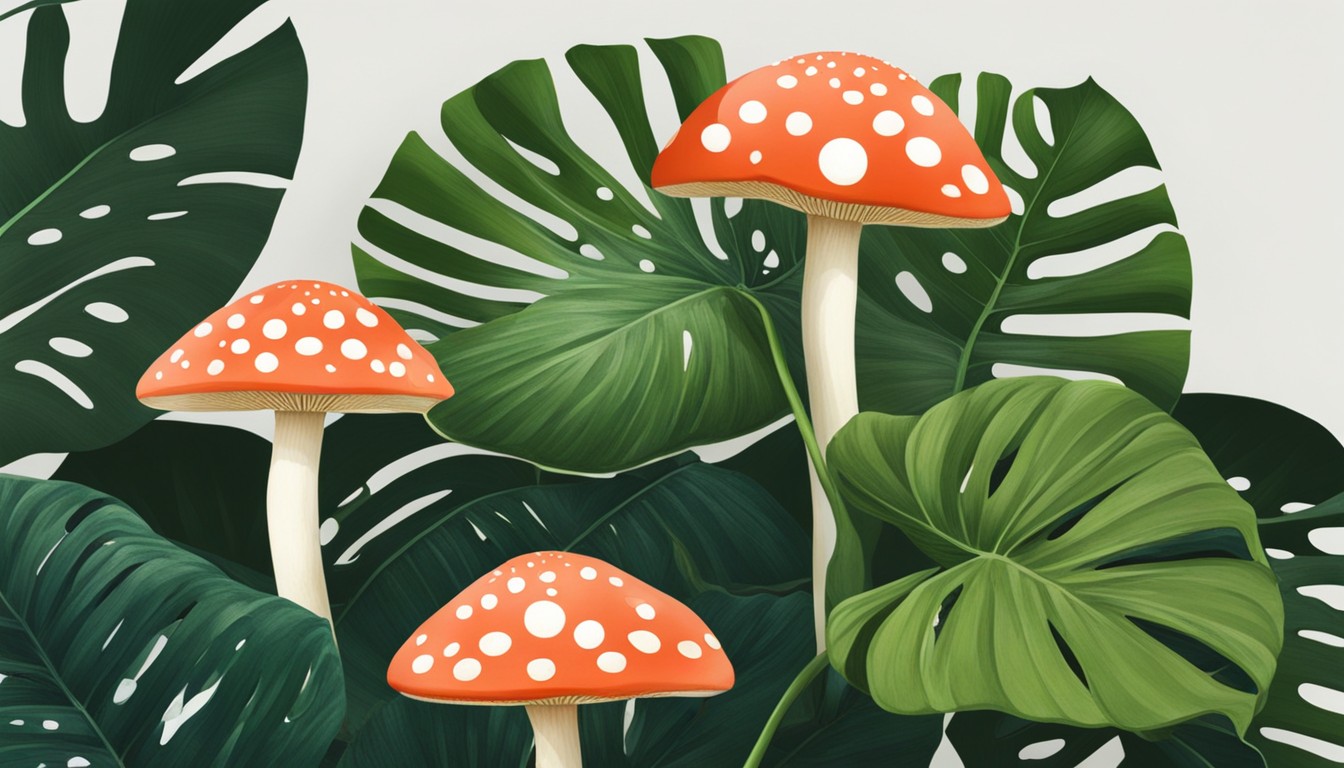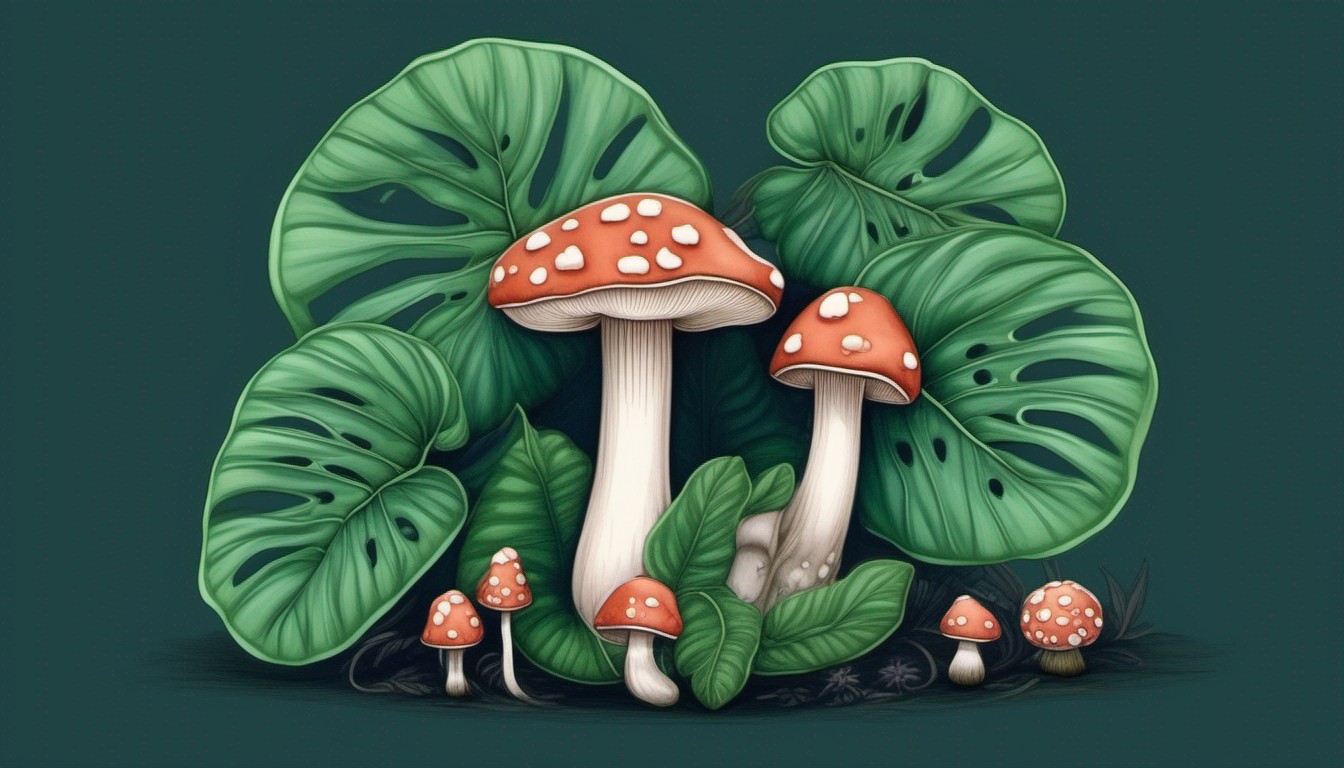Mushrooms in Monstera: A Guide to Identifying Fungi in Your Plant explores the fascinating relationship between mushrooms and the popular Monstera plant. This comprehensive guide provides expert tips and techniques for identifying different types of fungi that may appear in your Monstera, ensuring you can differentiate between harmless varieties and potentially harmful ones. From understanding the lifecycle of mushrooms to recognizing common characteristics and signs of fungal growth, this guide equips plant enthusiasts with the knowledge needed to maintain the health and beauty of their Monstera. With its informative approach and attention to detail, this blog post is an essential resource for anyone curious about mushrooms in Monstera plants.
Why Identify Fungi in Your Monstera Plant
To ensure the health and longevity of your Monstera plant, it’s imperative to identify and understand the role of fungi. Fungi can signal nutritional imbalances and have the potential to cause disease, but also contribute to the plant’s overall ecosystem.
Fungi in Monstera plants play a critical role in maintaining ecosystem balance, aiding nutrient absorption, and promoting growth resilience, marking potential threats and opportunities.
Through the lens of the Monstera plant, the complex world of fungi becomes approachable. Peeling back the layers of this mysterious world reveals a delicate balance of mutual benefits and potential threats, influencing the vital processes such as nutrient absorption and growth resilience.
The Importance of Identifying Fungi
Foremost, detecting fungi in Monstera plants helps owners monitor the health of their plant and curtail the spread of diseases early on. If left unnoticed, fungal infestations can lead to stunted growth and distinct aesthetic damage, diminishing the plant’s overall appeal.
Equally important is that the identification of fungi is crucial to survival. Some fungi are beneficial, assisting in nutrient absorption. In stark contrast, detrimental fungi can wreak havoc on the plant, impeding its capability to absorb water and important nutrients.
Efficiently identifying fungi, therefore, entails recognizing these differing fungi types, paving the way towards informed care decisions. Regular scrutiny and early identification play pivotal roles in maintaining plant integrity and preventing undue damage to your cherished Monstera.
Potential Risks and Benefits
Fungi, found in your Monstera, pose a delicate balance of risks and benefits. While some are synonymous with plant disease, others can play a pivotal role in nutrient absorption and protection against harmful elements.
Consider the possible threats fungi may introduce. Certain types can lead to severe damage, including root rot, leaf discoloration, and in extreme cases, the death of your Monstera plant.
On the brighter side, not all fungi are harmful. Mycorrhizal fungi, for example, establish a symbiotic relationship with the plant. They aid in nutrient uptake, making your Monstera stronger and more resilient.
However, the challenge lies in correctly identifying these microscopic organisms. Incorrect identification can lead to unnecessary or harmful treatment, potentially damaging your plant further.
Careful assessment and understanding of these threats and advantages encourage proactive decision-making. A well-informed Monstera plant owner can tailor effective care strategies, leading to healthier and more vibrant greenery.
Common Types of Fungi Found in Monstera Plants
Decoding the types of fungi found in your Monstera plant can be an enlightening step towards effective plant care. Gaining insight into these common fungi types will help create a healthier environment for your Monstera to flourish.
- Pleosporales: Fungi often found on the leaves causing dark spots and lesions.
- Botrytis cinerea: An aggressive fungi known to cause blight or gray mold on leaves.
- Rhizoctonia Solani: Known to cause damping off, root and collar rot.
- Phytophthora Parasitica: Often results in root rot and can lead to the death of the plant.
- Penicillium digitatum: Recognizable by its yellow-green spores, this fungi primarily causes fruit decay.
Understanding Different Types of Fungi
Delving into the world of fungi opens a new dimension for Monstera growers. A keen understanding of macroscopic and microscopic fungi types provides a comprehensive lookout, significantly impacting the plant’s overall health.
Grasping the distinguishing traits among fungi types assists Monstera enthusiasts in effectively identifying fungal growths. Recognizing the unique characteristics of common fungi lets you promptly spot and treat fungal infections in your precious Monstera plant.
Macroscopic Fungi vs. Microscopic Fungi
Macroscopic fungi, visible to the unaided eye, generally result in notable changes in Monstera’s appearance and health. Conversely, microscopic fungi, undetectable without magnification, may subtly influence the plant’s growth and vitality.
In your Monstera, both macroscopic and microscopic fungi can uniquely affect the plant’s health. Macroscopic fungi typically present more apparent symptoms, while microscopic ones may cause less noticeable yet equally noteworthy impacts.
Common Characteristics of Fungi
To understand the presence of fungi in Monstera plants, one must duly recognize the common traits that fungal growth embodies. This awareness of characteristic behaviors allows for optimal plant care and prompt treatment.
- Manifestations of Fungal Presence: Appearance of discoloration or spots on leaves, mushy or rotting roots, slow growth rate in adverse conditions
- Recognizing Fungal Growth in Monstera: Observation of white, powdery substance on the plant, presence of a peculiar smell, and stunted development
Identifying Fungal Growth in Monstera Plants

Detecting fungal growth in Monstera plants involves a keen observance of tell-tale signs such as color changes, unusual spots, or texture changes on the leaves, stem, or roots. Regular inspections, especially in damp conditions, establish essential practices in effective fungal detection.
In order to identify fungal infections in Monstera plants, a meticulous exploration and understanding of detection methods is vital. This includes studying the life-cycle of various fungi, their common habitats within the plant, and their impact on the plant’s overall health.
Visible Signs of Fungi
In the world of Monstera plant care, visible signs of fungi often serve as a forewarning of potential harm to the plant’s health. By observing your Monstera closely, you can identify these fungal attacks early and act swiftly to ensure your plant’s livelihood.
- Yellowing, wilting, or browning of leaves
- White, brown, or black spots on the leaves
- Presence of powdery substance on the leaves or stems
- Mushrooms or fungal growth around the base of the plant
- Unusually soft or mushy roots
Common Areas of Fungal Growth
Fungal growth in Monstera plants typically occurs in certain zones. These ‘fungal hotspots’ are specific areas that provide favorable conditions for fungi, making them primary targets for infection.
- The root system: An overwatered and poorly drained Monstera plant often harbors fungal infections in the root area.
- The plant stem: Particular fungi types like to attach themselves to the plant’s stem – specifically around the nodal areas where new leaves sprout.
- Leaf undersides: Fungi often find refuge in the humid microclimate created under the leaves of the Monstera plant.
- The soil surface: Some fungal species, especially those forming visible structures like mold or mushrooms, can often be seen directly on the soil surface.
How to Properly Inspect Your Monstera Plant for Fungal Growth
Setting up a systematic inspection routine is a essential step in identifying fungal growth in your Monstera plant. Consistent observation allows you to recognise any suspicious changes, mould formations, or fungal growths early, enabling you to respond promptly and effectively.
- Establish a regular examination timetable – Daily or weekly checks can help you spot any abnormal changes.
- Focus on typical fungal hot-spots – The leaves, roots, and soil are common areas where fungi may develop.
- Keep a record of the plant’s health – Documenting changes can help you compare the plant’s health over time.
- Look for telltale signs of fungal growth – Discoloration, wilting, or powdery substances may indicate an issue.
- Don’t disregard any part of the plant – Inspect the leaves, stem, roots, and the underlying soil to ensure thorough examination.
Common Fungal Infections in Monstera Plants

Monstera plants can be susceptible to a variety of fungal infections, among the most common include powdery mildew, root rot, and leaf spot. Being well-informed about these threats is an essential part of proactive plant care.
Recognizing fungal pathogens in monstera plants signifies gaining knowledge on their different appearances and behaviors. While some spread a white powder-like substance, others may cause yellowing, wilting, or irregularities in leaf growth.
Prevention of fungal infection in monsteras begins with understanding these intruders – their triggers, progression patterns, and methods of attack. Combating these invaders requires awareness, appropriate intervention, and ongoing prevention strategies.
Powdery Mildew
Powdery Mildew is a common fungal disease, presenting as a white, flour-like substance on the undersides of Monstera leaves. If left untreated, it may lead to leaf yellowing, curling or wilting, compromising the overall health of the plant. Countermeasures include proper air circulation and timely application of organic fungicides.
The name ‘Powdery Mildew’ is derived from its characteristic appearance. It starts as small, dust-like spots and eventually covers significant leaf surface. Its devastating effects on plant aesthetics and health underline the need for immediate attention.
Monstera plants affected with Powdery Mildew can display a drastic decline in vitality. The plant might suffer from stunted growth due to the energy diverted to combat the fungal entity. Regular plant examination can aid in early diagnosis and effective management of this condition.
Root Rot
A silent attacker, root rot targets the Monstera’s life-support system, the roots, causing plants to lose vitality. This fungal disease occurs when overwatering or poor drainage provides a thriving environment for fungi like Pythium, Fusarium, or Rhizoctonia, leading to discolored, decaying roots.
Accurate diagnosis prevents further damage. Foliage yellowing, wilted leaves, lethargic growth often serve as surface-level indications of root rot. Implementing preemptive strategies like regimented watering, ensuring ample drainage provisions, and maintaining good hygiene can help safeguard Monstera plants from this unassuming affliction.
Leaf Spot
Leaf Spot is a fungal infection identifiable by dark or discolored patches appearing on Monstera plant leaves. Swift detection is crucial for preventing the spread of this pestilent fungus that can severely hamper plant growth.
Understanding Leaf Spot’s impact is vital to ensure your Monstera thrives. This fungi diminishes photosynthesis, impedes nutrient distribution and accelerates leaf decay, which can cause the plant’s overall health to deteriorate.
If your Monstera manifests symptoms of Leaf Spot, immediate action is required. Remove infected leaves, increase ventilation, and apply fungicidal treatments to combat infection. Regular monitoring helps in prevention and swift action when needed.
Steps to Safely Remove Fungi from Your Monstera Plant

In a bid to validate successful fungi elimination from Monstera plants, a strategic, well-curated action plan is imperative. The procedure ensures the fungi is efficiently terminated without disrupting the overall health of the plant.
Providing a step-by-step guide, it aims to meticulously extract fungi from the Monstera with caution, minimizing risk of unwanted damage. It offers tangible solutions, combining professional insight with practical applications for homeowners to undertake.
Preparing for Removal
Before tackling fungi removal from your Monstera plant, it’s crucial to take certain precautions. These include isolating the infected plant to prevent the spread of fungi to healthy plants, wearing gloves for protection, and having a disposal system ready for the fungi removed.
Gearing up for fungi extraction entails being equipped with the right tools, such as a sterilized cutting tool for larger infestations and a soft cloth for mild cases. It’s also vital to plan for an aftercare regimen for your Monstera plant to aid its recovery after the fungal removal process.
Proper Cleaning Techniques
Good sanitation methods for fungi elimination in Monstera plants require mastery. The right blend of caution, precision and well-considered steps ensures not only effective cleaning but also safeguards the plant’s general well-being.
Persistence should be reinforced in your cleaning routine. Regular, thorough cleaning of your Monstera plant’s leaves, while being mindful of the water-content mix ratio, mitigates chances of recurring fungal growth.
The art of precision is pivotal in effective fungal removal in Monstera plants. Carefully navigate the plant, cautiously cleaning surfaces while avoiding excessive pressure which could lead to plant damage.
Successful cleaning strategies involve understanding your Monstera plant, knowing its weak points for fungal attacks, and focusing cleaning actions on such spots. Knowledge is your prime tool for effective fungi removal.
Preventing Future Fungal Growth
Investing in preventative care for your Monstera plant can secure its overall well-being and longevity. Consider regular monitoring and implement a consistent regimen of watering, cleaning, and sun-exposure to curb potential fungal infiltration.
Advanced techniques offer a forward-thinking approach to hindering fungal growth. Using specialized soil mixtures, or adding anti-fungal agents to your watering routine can act as a safeguard.
Be vigilant in maintaining optimal environmental conditions for your Monstera. Low humidity, moderate temperatures, and ample light can thwart the growth and spread of fungi.
Understanding the fungi that typically infect Monstera plants is crucial in prevention. Comprehensive knowledge will allow you to recognize early warning signs and enact appropriate response measures.
Do not overlook the importance of regular and thorough cleaning in preventing fungal attack. Clean the leaves, check the root systems, and sterilize your garden tools to ensure a fungi-free environment for your plant.
Seeking Professional Help for Severe Fungal Infections
At times, a fungal outbreak in your Monstera plant may escalate beyond at-home solutions, demanding professional intervention. Severe fungal infections can manifest as extensive plant discoloration, dramatically reduced foliage health, and persistent or worsening symptoms despite targeted care efforts.
Investing in expert assistance during severe fungal emergencies can provide comprehensive solutions and safeguard your plant’s longevity. A seasoned plant specialist can identify the exact fungal species plaguing your Monstera, quicken recovery with specialized treatments and equip you with preventative measures to fortify against future threats.
When to Consult an Expert
Despite the best efforts, some fungal infestations in Monstera plants can become severe, necessitating the intervention of a professional plant care specialist. Rapid spread, persistent infections, or recurring issues may signal that it’s time to seek expert assistance.
Yellowing or browning foliage, extreme wilting, and loss of vigor, when accompanied by visible unaffected fungal patches, often indicate a deep-rooted problem. If there is no improvement after implementing at-home remedies, it’s wise to consult an expert.
For significant infestations, reaching out to a plant pathologist would be beneficial. Experts can pinpoint the exact type of fungi affecting your Monstera, advise on the appropriate course of treatment, and help you prevent future infections.
Timing often plays a crucial role in preventing the overrunning of fungi on your Monstera. Recognize the signs of severity and act promptly. Delaying expert consultation can lead to irreparable damage to your plant, or worse, an infestation spreading to other plants.
It’s essential to note that while a certain level of fungus is normal, an unchecked growth of harmful fungi can spell disaster for your Monstera’s overall health. When the situation becomes challenging to manage, it’s crucial to enlist professional help for effective and lasting solutions.
Tips for Finding a Qualified Plant Specialist
An invaluable resource on your path towards Monstera fungal eradication could be a qualified plant specialist. Their unique blend of knowledge, expertise, and experience could provide invaluable insights and tailored solutions to effectively combat and prevent fungal infections in your Monstera plant.
When searching for a Monstera fungus-savvy specialist, your priority should be unearthing someone who possesses an intricate understanding of this particular plant. Be diligent in your search, comparing specialist qualifications, areas of focus, and customer testimonials to ensure an optimal fit and successful fungal remediation.
Other Resources for Monstera Plant Care
Having the right tools can aid greatly in your fight against fungi. A toolkit for managing Monstera fungal issues can consist of fungicides, sterile cutting tools, and plant-safe cleaning agents. Online guides, YouTube tutorials, and e-books provide insightful tips on applying these tools effectively.
Greatly enhance your plant care abilities by tapping into other useful resources. Online forums offer a wealth of shared experiences, community tips, and solutions for tackling stubborn fungal growths. Webinars offer a practical way to learn from horticulture experts.
Consider mobile apps dedicated to plant health monitoring. These utilize your phone’s camera to identify issues, suggest remedies, and even remind you of care schedules to prevent future fungal infections. Smart home gadgets can monitor light levels, humidity, and temperature, flagging any imbalances for remediation.
Frequently Asked Questions
Uncover the complexities of mushrooms in Monstera and arm yourself with the expert knowledge required to ensure the health and vitality of your beloved plant.
1. What are mushrooms in Monstera plants?
Mushrooms in Monstera plants are fungal growths that can appear in the soil or on the plant’s roots, stems, or leaves. These mushrooms vary in size, color, and shape, adding an intriguing and sometimes mystical aspect to the already stunning Monstera foliage.
2. Are mushrooms in Monstera plants harmful?
While not all mushrooms in Monstera plants are harmful, some varieties can pose a risk to the plant’s health. Certain types of fungi can cause root rot or interfere with the plant’s nutrient absorption, leading to decreased vitality. Identifying and differentiating between harmless and potentially harmful mushrooms is crucial for the well-being of your Monstera.
3. How can I identify mushrooms in my Monstera plant?
Identifying mushrooms in your Monstera plant requires keen observation and knowledge of common features. Look for distinctive characteristics such as color, shape, texture, and patterns on the mushroom’s cap and stem. Consulting a reliable field guide or seeking advice from a plant expert can also be beneficial.
4. Can I remove mushrooms from my Monstera plant?
Yes, you can remove mushrooms from your Monstera plant to prevent potential harm. Gently twist or cut them at the base, being careful not to disturb the plant or spread the mushroom spores. It is advisable to wear gloves to protect yourself during this process.
5. How can I prevent mushrooms from growing in my Monstera plant?
To prevent mushrooms from growing in your Monstera plant, it is essential to maintain a healthy growing environment. Ensure proper drainage by using well-draining soil and pots with drainage holes. Avoid overwatering and excessive moisture, as mushrooms often thrive in damp conditions. Additionally, provide good air circulation and periodically inspect your plant for signs of fungal growth.
6. Should I be concerned if mushrooms appear in my Monstera plant?
If mushrooms appear in your Monstera plant, it is important to be attentive and cautious. Observe the overall health of the plant and monitor for any signs of distress. If you suspect the mushrooms are harmful or if the plant shows signs of decline, it is advisable to seek guidance from a professional or experienced plant enthusiast.
Remember, mushrooms in Monstera plants can add intrigue and beauty but should be managed carefully to maintain the health and vitality of your beloved plant. By staying informed and taking proactive measures, you can ensure a thriving environment for your Monstera.
Conclusion
Cultivating a deeper understanding of fungi, their identification, removal, and prevention, paves the way for healthier, thriving Monstera plants. This culminating discussion highlights the need to redirect focus on proper Monstera care and continuously combating fungal challenges.
- Re-evaluate fungi handling strategies regularly
- Stay ahead of fungal issues through proactive and regular inspections of Monstera
- Seek professional aid at the first sign of severe fungal infections
- Implement prevention strategies post fungal removal to warrant long-term plant health
- Stay attuned with latest findings on Monstera care and fungal challenges

